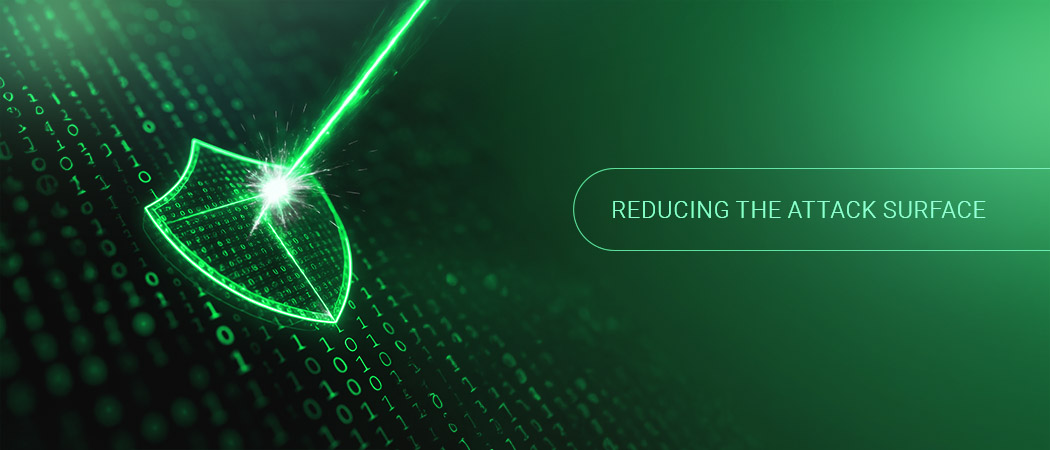Cyber attacks, like other types of security incidents, range dramatically in scope and impact. When defenders are prepared, an incident may be contained, damage limited, and recovery swift. When caught unprepared, a single incident may result in days or weeks of downtime, lost revenue, tarnished reputation, regulatory penalties or class action settlements [1][2]. In May 2024, Change Healthcare forecasted an expected loss of 1.6 billion Dollar. As of January 2025, the total cost of the Change Healthcare ransomware attack has reached almost 3 billion Dollar [3][4].

The totality of damage caused by an IT security breach, known as the “blast radius”, depends on many factors. These factors include whether vulnerabilities are being managed, if a defense in depth approach to cybersecurity has been applied, network segmentation, effective backup strategies and more. Negligent security hygiene is an open invitation to attackers, resulting in more costly outcomes like extensive data theft, ransomware extortion and even destructive wiper attacks used for industrial sabotage. A recent report found that once inside a network, attackers now deploy ransomware within 48 minutes on average and CVE disclosures are being weaponized into exploits within 18 days.
This article explores the concept of a cyber attack “blast radius” and the role that effective Vulnerability Management plays in containing the fallout from cyber intrusions. With the right controls in place, the damage from a cyber breach can be minimized and worst-case outcomes prevented
What is the “Blast Radius” of a Cyber Breach?
The term “blast radius” is military jargon referring to the physical area damaged by an exploding bomb. In digital systems, the term similarly refers to the extent of damage caused by a cyber attack. How many systems did an attacker compromise? Were they able to subsequently compromise critical systems after initial access? Did they breach adjacent networks or cloud assets?
Far-reaching damage is not a foregone conclusion when hackers gain initial access. Defenders can effectively cut off the attack at an early stage, preventing malicious actors from achieving their ultimate objectives or causing far reaching damage.
The Consequences of a Bigger Blast Radius
While forfeiting unauthorized access to an adversary is bad, it’s the subsequent stages of an attack that keeps IT security managers up at night. The latter stages of a cyber breach such as installing malware on critical assets, exfiltrating sensitive data, or encrypting files have the most profound implications for organizations. As blast radius increases, it is much more likely that an organization will experience a significantly negative impact.
Increased blast radius can result in:
- Longer “Dwell Time”: Lateral movement and persistence techniques can allow attackers to remain undetected for extended periods, gathering intelligence and preparing subsequent attacks.
- Increased financial losses: Service disruptions and ransomware attacks contribute to higher financial losses, lost revenue from downtime, risk of regulatory penalties and erode business relationships.
- Increased operational downtime: The impact of operational downtime can reverberate across an organization causing delays, frustration and desynchronizing operations.
- Loss of sensitive data: Attackers seek to exfiltrate sensitive data to support espionage campaigns or extort victims into paying ransom.
- Compromised trust: Unauthorized access to messaging systems or third-party assets can erode trust among stakeholders, including customers, employees and business partners.
Greenbone Reduces the Blast Radius of a Cyber Breach
Vulnerability Management is a powerful factor in reducing the so-called “blast radius”. Effective mitigation of security gaps can leave an adversary with no easily accessible means to extend their initial foothold. Vulnerability management is most efficiently and effectively implemented by automatically scanning for security weaknesses throughout a network infrastructure and remediating the attack surface. In doing so, organizations can greatly reduce the potential blast radius of a successful cyber attack and also reduce probability of being breached in the first place.
Threat Mapping helps IT security teams understand their attack surfaces, the locations where adversaries may be able to enter a network. Greenbone’s core capabilities support Threat Mapping efforts with system and service discovery scans and by scanning both network and host attack surfaces allowing defenders to reduce their attack surface by 99%. Furthermore, Greenbone provides real-time reporting and alerts to keep security teams informed of emerging threats, enabling a proactive cybersecurity posture and timely remediation. This proactive, layered approach to cybersecurity reduces the potential blast radius and results in better security outcomes. Defenders are afforded more time to detect an attacker’s presence and eliminate it before catastrophic damage can be done.
The Strongest Defenses with Greenbone Enterprise Feed
The strongest defenses come from Greenbone’s industry leading Enterprise Vulnerability Feed. In total, the Greenbone Enterprise Feed has approximately 180,000 vulnerability tests and counting which can detect both general security compliance weaknesses and application specific vulnerabilities. Our Enterprise Feed adds hundreds of new tests each week to detect the newest emerging threats.
Here is a list of IT assets that Greenbone is designed to scan:
- Internal network infrastructure: Scanning internal network devices with any type of exposed service, such as databases, file shares, SNMP enabled devices, firewalls, routers, VPN gateways and more.
- On-premises and cloud servers: Attesting server configurations to ensure compliance with security policies and standards.
- Workstations: Greenbone scans workstations and other endpoints across all major operating system (Windows, Linux, and macOS) to identify the presence of known software vulnerabilities attesting compliance with cybersecurity standards like CIS Benchmark
- IoT and peripheral devices: IoT and peripheral devices, such as printers, use the same network protocols for communication as other network services. This allows them to be easily scanned for device and application specific vulnerabilities and common misconfigurations similarly to other network endpoints.
Reducing Network Attack Surface
Network attack surface consists of exposed network services, APIs and websites within an organization’s internal network environment and public facing infrastructure. To scan network attack surfaces, Greenbone builds an inventory of endpoints and listening services within target IP range(s) or a list of hostnames, then scans for known vulnerabilities.
Greenbone’s network vulnerability tests (NVTs) consist of version checks and active checks. Version checks query the service for a version string and then compare it for matching CVEs. Active checks use network protocols to interact with the exposed service to verify whether known exploit techniques are effective. These active checks use the same network communication techniques as real world cyber attacks, but do not seek to exploit the vulnerability. Instead, they simply notify the security team that a particular attack is possible. Anything an attacker can reach via the internet or local network, Greenbone can scan for vulnerabilities.
Reducing Host Attack Surface
Host attack surface is the software and configurations within individual systems that cannot be accessed directly via the network. Reducing the host attack surface minimizes what an attacker can do with initial access. Greenbone’s authenticated scans conduct Local Security Checks (LSC) to assess a system’s internal components for known weaknesses and non-compliant configurations that could allow attackers to escalate their privilege level, access sensitive information, install additional malware or move laterally to other systems.
Greenbone’s Enterprise Feed includes families of LSC for each major operating system including Ubuntu, Debian, Fedora, Red Hat, Huawei, SuSE Linux distributions, Microsoft Windows, macOS and many more.
Post-Breach Tactics: the Second Stage of Cyber Intrusions
Once attackers gain a foothold within a victim’s network, they engage in secondary exploitation techniques to deepen their access and achieve their objectives. In the modern cybercrime ecosystem, Initial Access Brokers (IABs) specialize in gaining unauthorized access. IABs then sell this access to other cybercriminal groups that specialize in second-stage attack tactics such as deploying ransomware or data theft. Similar to breaching the walls of a fortress, after initial access, an organization’s internal network becomes more accessible to attackers.
Some tactics used during the second stage of cyber attack include:
- Privilege escalation [TA0004]: Attackers seek ways to elevate their access rights, allowing them access to more sensitive data or to execute administrative actions.
- Lateral movement [TA0008]: Attackers compromise other systems within the victim’s network, extending their access to high-value resources.
- Persistent remote access [TA0028]: Creating new accounts, deploying backdoors or using compromised credentials, attackers seek to maintain their access even if the initial vulnerability is remediated or their presence is detected.
- Credential theft [TA0006]: Stolen sensitive data can be processed offline by attackers attempting to crack passwords, break into protected resources or plan social engineering attacks.
- Accessing messaging systems [T1636]: Accessing organizational messaging platforms or collaboration tools gives access to sensitive information which can be used to conduct social engineering attacks such as spear phishing, even targeting external partners or customers.
- Encryption for impact [T1486]: Identifying critical assets, financially motivated adversaries seek to maximize impact by deploying ransomware and extorting the victim to return access to the encrypted data.
- Data exfiltration [TA0010]: Downloading a victim’s sensitive data can be used for espionage and also gives attackers leverage to extort victims into paying to not release it publicly.
- Denial of Service attacks [T0814]: Service disruption can be used for further extortion or as a distraction to execute other attacks within the victim’s network.
Summary
Blast radius refers to the scope of damage that an adversary imposes during a cyber attack. As attacks progress, adversaries seek to penetrate deeper, gaining access to more sensitive systems and data. Lack of cyber hygiene gives attackers free reign to steal data, deploy ransomware and cause service disruptions and complicates detection and recovery. Minimizing attack surface is crucial for reducing the potential impact of a cyber breach and helps ensure a better security outcome.
Greenbone’s core contribution to cybersecurity is to increase security visibility in real-time, alerting defenders to vulnerabilities and giving them the opportunity to close security gaps, preventing hackers from exploiting them. This includes both network attack surface: public-facing assets, internal network infrastructure, cloud assets and host attack surface: internal software applications, packages and common misconfigurations.
By delivering industry-leading vulnerability detection, Greenbone empowers real-time threat visibility, empowering defenders to proactively ensure that adversaries are decisively neutralized.



